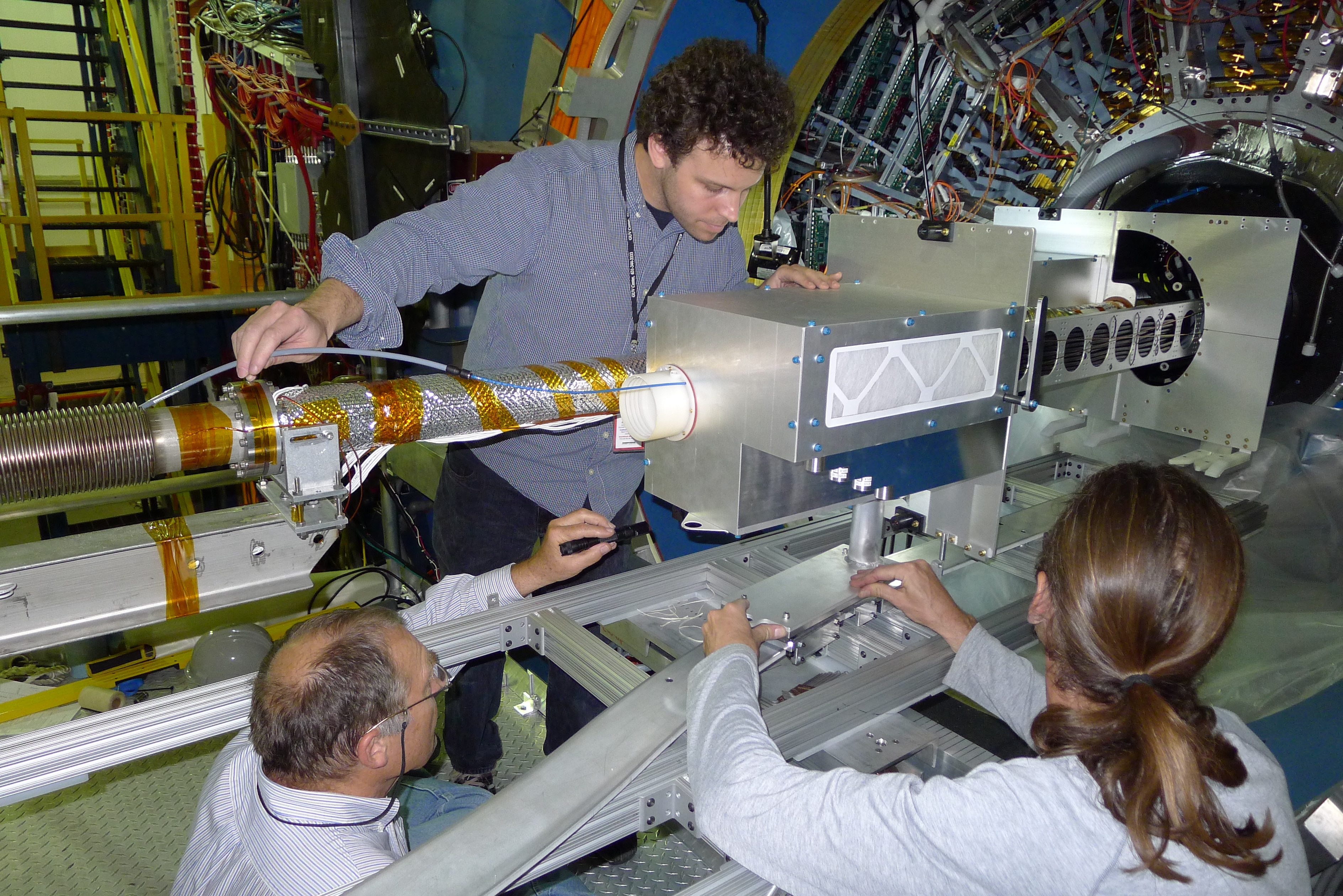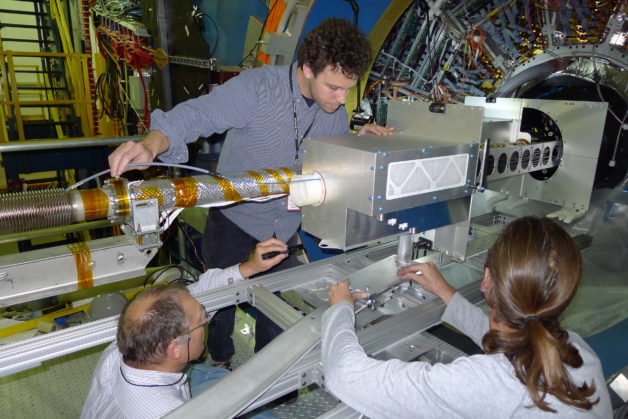
The Heavy Flavor Tracker during insertion into the STAR detector. Pictured at bottom left is Howard Wieman, the lead designer of the HFT. (Credit: Leo Greiner/Berkeley Lab)
By teasing out signatures of particles just tenths of a millimeter from the center of a trillion-degree fireball that mimics the early universe, nuclear physicists from the Department of Energy’s Lawrence Berkeley National Laboratory (Berkeley Lab) and from other sites are gaining new insights about fundamental physics. They achieved this by smashing together gold nuclei at the Relativistic Heavy Ion Collider (RHIC).
Particle collisions at RHIC, located at DOE’s Brookhaven National Laboratory, regularly recreate tiny specs of quark-gluon plasma (QGP), the so-called subatomic “soup” that contains the building blocks of visible matter.
The collisions free the quarks and gluons from their confinement within ordinary particles—the protons and neutrons that make up the nucleus of atoms—so nuclear physicists can study their interactions and the force that holds them together in the universe today. The quarks and gluons in this plasma last existed as free particles in the very early universe, some 14 billion years ago.
The new measurements, detailed in a study published in Physical Review Letters, are the first to come from a precision upgrade to RHIC’s STAR detector known as the “Heavy Flavor Tracker” (HFT). The paper gives details about the first direct measurement at RHIC of how a type of heavy particle containing a “charm” quark gets caught up in the flow of the expanding fireball. This measurement—a testament to the capabilities of the HFT—gives scientists a new window into understanding the interactions of the particles that make up the subatomic soup.
“The precision of our measurement is unprecedented,” said Xin Dong, a physicist at Berkeley Lab who led the postdocs and students conducting the physics analysis on the heavy flavor results. “It was extremely challenging due to interference from thousands of other particles produced in the same heavy ion collisions—a bit like picking a needle out of a haystack.”
Brookhaven physicist Zhangbu Xu, the spokesperson of the STAR experiment, said, “By comparing our measurements with theoretical predictions that include the various parameters that play a role in these interactions, we can learn about how these different properties relate to one another, and ultimately why the quark-gluon plasma behaves the way it does.”
Particles containing heavy quarks are considered ideal probes for understanding quark-gluon plasma because they may interact differently with the plasma than light quarks do, offering up subtle clues about the plasma’s properties. But the QGP spits out particles containing heavy quarks only rarely, amid thousands of other particles made of the lighter varieties of quarks.
The few heavy particles that do emerge decay into other particles almost instantly—mere fractions of a millimeter from the QGP fireball in which they were created. This rarity and rapid decay make heavy particles difficult to detect.
STAR’s HFT, a state-of-the-art tracking device now sitting at the center of the house-sized detector, tracks these elusive but important heavy particles.
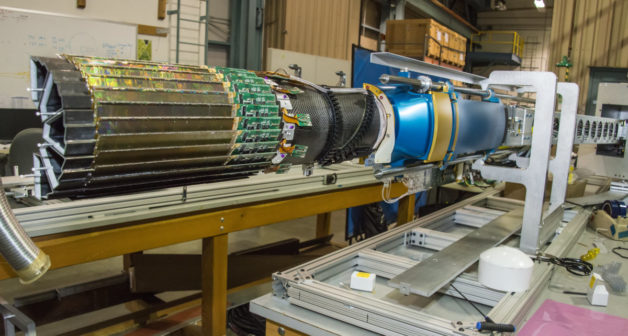
The Heavy Flavor Tracker prior to installation at Brookhaven Lab. (Credit: Roy Kaltschmidt/Berkeley Lab)
Designed and developed by a team of nuclear physicists led by senior scientist Howard Wieman at Lawrence Berkeley National Laboratory, now retired, the HFT is the first silicon detector at a collider that uses a technology found in digital cameras called monolithic active pixel sensor technology.
The ultrathin sensors in the HFT—unlike many of the particle detection components of STAR—sit very close to the central beampipe in which the collisions take place. While not quite close enough to detect the heavy charm quark itself, this location and the detector’s high resolution (composed of 360 million pixels each measuring 20-by-20 millionths of a meter) allow it to pick up signs of the heavy particles’ decay.
For this latest study, STAR physicists were tracking particles called kaons and pions that emerge when charm-quark-containing particles known as a D-zeros (D0s) decay.
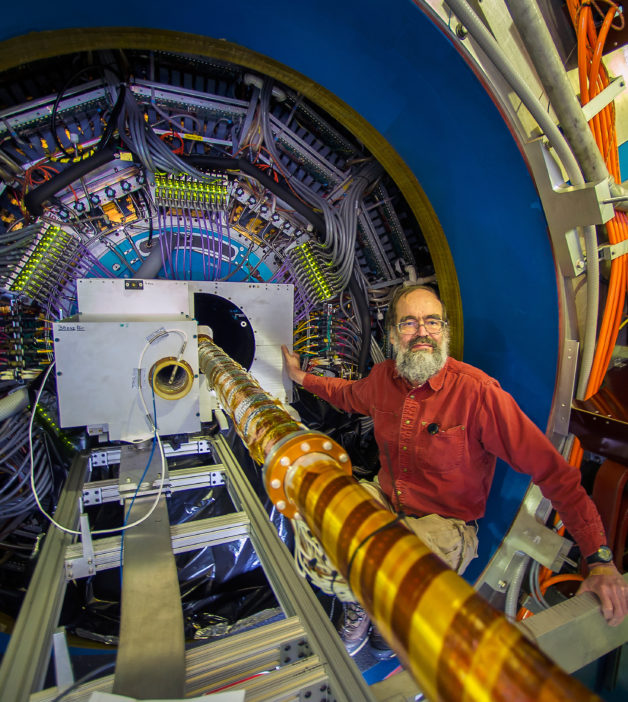
Brookhaven Lab physicist Flemming Videbaek during installation of the Heavy Flavor Tracker at the STAR detector at RHIC, a world-class particle collider at Brookhaven National Laboratory. (Credit: Brookhaven Lab)
“We use the HFT to look for kaons and pions that are very close to one another— within fractions of a millimeter of one another—whose paths from the collision emerge from a single point that’s away from the collision vertex, but not very far— about 100-500 microns,” said Flemming Videbaek, a Brookhaven Lab scientist and the contract project manager for the HFT.
Spiros Margetis, a professor at Kent State University who is a member of the collaboration, added, “The STAR HFT has achieved, so far, the best resolution in all high-energy experiments, which allows for the necessary precision to determine the D0 decay point in a very complex heavy ion collision.”
That’s the distance D0s travel before they decay, he explained. If the kaon and pion have just the right mass and trajectories emerging from such a point, the scientists can conclude that they originated from a D0 at that spot—and use these measurements to track the emergence of D0s from all around the QGP.
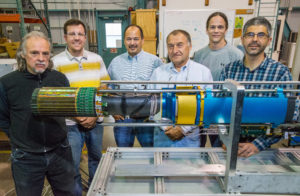
Berkeley Lab’s Heavy Flavor Tracker team included (from left) Mario Cepeda, Kenneth Wilson, Leo Greiner, Howard Wieman, Thomas Johnson and Giacomo Contin. (Photo by Roy Kaltschmidt/Berkeley Lab)
The Berkeley Lab and a Kent State University group, together with other groups—including the software and computing team at Brookhaven Lab—developed the software that allowed scientists to connect the particle traces from the HFT detector with other components of the house-sized STAR detector.
The findings, based on an analysis of tens of thousands of sought-after particle events in 1.1 billion collisions, were somewhat surprising, researchers noted.
When two spherical gold ions collide off-center, the pattern of the collision is an oblong overlap—something like a football standing on end. STAR physicists found more D0s emerging from the fat part of the “football” than from its pointy ends, implying that heavy quarks are thermalized in the quark-gluon soup produced in the high-energy collisions at RHIC. D0s are created in the earliest part of the collision, when quarks and gluons are free.
This pattern of so-called “elliptic flow” was familiar from measurements of lighter particles emerging from the QGP. The new observations suggest that heavy-quark interactions inside the quark-gluon plasma are so strong that the heavy quarks themselves become part of the quark-gluon “soup,” said Xin Dong.
Grazyna Odyniec, leader of Berkeley Lab’s Relativistic Nuclear Collisions Program, added, “The discovery of the elliptic flow of a very massive charm quark is of fundamental importance for our understanding of quark-gluon plasma phase dynamics. It opens up a broad range of theoretical speculations about the nature of a possible mechanism or mechanisms behind this observation.”
The Relativistic Heavy Ion Collider is a DOE Office of Science User Facility.
This research was supported by the DOE Office of Science and by all the agencies and organizations that support research at STAR.
Note: This news release was adapted from a Brookhaven National Laboratory press release. View the Brookhaven Lab release.
# # #
Lawrence Berkeley National Laboratory addresses the world’s most urgent scientific challenges by advancing sustainable energy, protecting human health, creating new materials, and revealing the origin and fate of the universe. Founded in 1931, Berkeley Lab’s scientific expertise has been recognized with 13 Nobel Prizes. The University of California manages Berkeley Lab for the U.S. Department of Energy’s Office of Science. For more, visit www.lbl.gov.
DOE’s Office of Science is the single largest supporter of basic research in the physical sciences in the United States, and is working to address some of the most pressing challenges of our time. For more information, please visit science.energy.gov.
